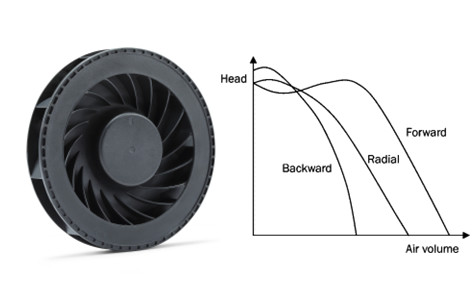Centrifugal fans
- Home>>News>>Company NewsCentrifugal fans
Centrifugal fans
Centrifugal fans consist of an impeller in a casing having a spirally shaped contour. The air enters the impeller in an axial direction and is discharged at the impeller outer periphery. The air flow moves along the centrifugal direction (or radial direction). Sometimes centrifugal fans are called radial flow type fans. Centrifugal fans are capable of generating relatively high pressures. They are suitable for high pressure applications as compared with axial flow fans. Generally centrifugal fans have three types of blade: forward blade, backward blade and radial blade. The characteristic curve of three kinds of centrifugal fan is shown in Figure.

They are frequently used in ‘dirty’ airstreams (high moisture and particulate content), in material handling applications and in systems at higher temperatures. They can be small, with sub 0.125 kW motors, or large, with hundreds of kW motors driving fans.
Type of fan | Applications | Advantages | Disadvantages |
Radial | (1) Industrial/mining/petrochemical (2) Dust extraction applications (3) High-pressure applications | (1) Suitable for high static pressures and high temperatures (2) Simple design allows custom-build units for special applications (3) Can operate at low air flows without vibration problems (4) High durability (5) Have large running clearances, which is useful for airborne solids (dust, wood chips and metal scraps) handling services | Only suitable for low–medium airflow rates |
Forward curved | (1) HVAC/industrial (2) Clean air supply & and extraction | (1) Can move large air volumes against relatively low pressure (2) Relative small size (3) Low noise level (due to low speed) and well suited for residential heating, ventilation, and air-conditioning (HVAC) applications | (1) Only suitable for clean service applications but not for high pressure and harsh services (2) Fan output is difficult to adjust accurately (3) Driver must be selected carefully to avoid motor overload because power curve increases steadily with airflow (4) Relatively low energy-efficiency (55–65%) |
Backward inclined | (1) HVAC/industrial (2) Clean air supply and extraction | (1) Can operate with changing static pressure (as this does not overload the motor) (2) Suitable when system behaviour at high air flow is uncertain (3) Suitable for forced-draft services (4) Flat-bladed fans are more robust (5) Curved-bladed fans are more efficient (exceeding 85%) (6) Thin air-foil bladed fans are most efficient | (1) Not suitable for dirty air streams (as fan shape promotes accumulation of dust) (2) Airfoil bladed fans are less stable because of staff as they rely on the lift created by each blade (3) Thin airfoil bladed fans subject to erosion |
Aerofoil blades | (1) Industrial/mining/petrochemical (2) Clean air supply and (3) extraction | (1) High efficiencies (85–90%) (2) High volume and medium to high pressure (3) (3) Non-overloading characteristics | (1) Extremely high labour input to manufacture |
Over the last 20 years centrifugal fans with backward curved blades have become more common within air handling. They are normally larger for the same volume and pressure characteristics and are a little more complicated to construct and so more expensive. Despite the cost disadvantage, they have become more popular in air handling units because their efficiency is higher than forward curved centrifugal fans. Centrifugal fans with forward curved blades always require a scroll housing. Their characteristic features are a low noise level, relatively small air flow with a high increase in static pressure and space-saving application.
- Max air flow fans
- Machine cooling fan
- Bitcoin digger fan
- Telecome fan
- Stage lamp fan
- Power cooling fan
- Laser module fan
- Min air flow fans
- 3D printer fan
- Amplifier fan
- Computer fan
- Inverter fan
- Charging pile fan
- Car LED lamp fan
Contact
Black@ruiapple.com
TEL:+86 13189756968
FAX:+86 755 88852020
Shenzhen Office: 508#,Tianhe biulding, Baoan Road,Shenzhen,China Factory add: 471#, West Wenwu Road, Economic and Technological Zone, Mianyang City, Sichuan Province, China
Copyright © 2019 SHENZHEN RUIAPPLE ELECTRONICS CO.,LTD Official Record No:粤ICP备19010273号
Support:RUIAPPLE










